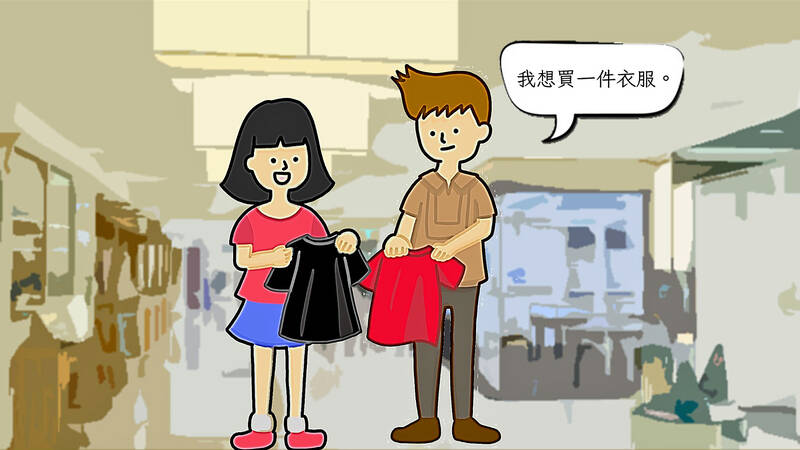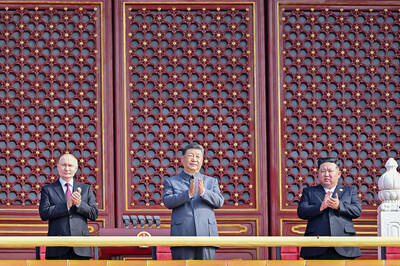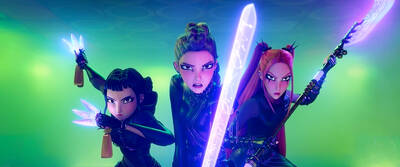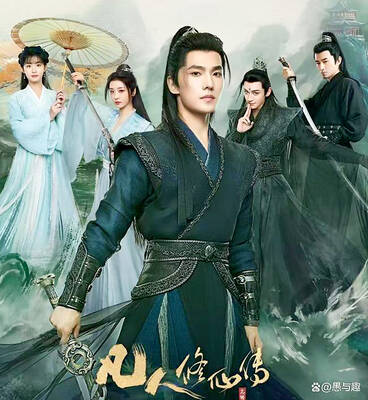對話 Dialogue
小實:你想買什麼?
Xiaoshi: Nǐ xiǎng mǎi shénme?

馬克:我想買衣服。
Make: Wǒ xiǎng mǎi yīfú .
小實:你喜歡黑色嗎?
Xiaoshi: Nǐ xǐhuān hēisè ma?
馬克:對啊,我喜歡黑色和紅色。
Make: Duì ā, wǒ xǐhuān hēisè hàn hóngsè.
小實:那……這一件黑色的衣服怎麼樣?
Xiaoshi: Nà. . . zhè yí jiàn hēisè de yīfú zěnmeyàng?
馬克:我想一想。這一件衣服多少錢?
Make: Wǒ xiǎngyìxiǎng. Zhè yí jiàn yīfú duōshǎoqián?
小實:一百塊錢。
Xiaoshi: Yìbǎi kuài qián.
馬克:好,我買這一件。
Make: Hǎo, wǒ mǎi zhè yí jiàn.
翻譯 Translation
Xiaoshi: What do you want to buy?
Mark: I want to buy clothes.
Xiaoshi: Do you like black?
Mark: Yes, I like black and red.
Xiaoshi: Then... how about these black clothes?
Mark: Let me think about it. How much are these clothes?
Xiaoshi: One hundred dollars.
Mark: Okay, I’ll buy this one.
單字片語 Vocabulary
1. 買 (mǎi) to buy
2. 件 (jiàn) measure word for clothes
3. 衣服 (yīfú) clothes
4. 黑色 (hēisè) black
5. 紅色 (hóngsè) red
6. 多少錢? (duōshǎoqián?)
How much is it?
7. 百 (bǎi) hundred
教材音檔 Audio Files
實踐大學華語中心提供
By Shih Chien University Chinese Language Center: https://chineseusc.com/

China commemorated 80 years since the end of World War II last week with a massive military parade against a backdrop of a disputed history about who ultimately defeated Japan. The issues, including Japan’s reckoning with its wartime record in China, are bound to flare again in December, a flashpoint anniversary of the mass killing in Nanjing by invading Japanese troops. Below is an explainer about what the different — and disputed — points of view are. WHAT IS CHINA’S VIEW? For the Chinese government sitting in Beijing, this is a clear-cut issue: China sacrificed 35 million people in a heroic and brutal struggle

Rarely does Nature present such a striking contradiction as the one found in Lencois Maranhenses National Park. Located along Brazil’s northeastern coast, the park unveils breathtaking scenery, where rippling sands meet crystal-clear lagoons. Under the sun’s golden glow, the waters glitter in shades of turquoise and emerald. So surreal is this spectacle that visitors might wonder if they’re gazing at a digitally modified photo rather than a living landscape. Were it not for the unique geographical and climatic conditions, such a marvel would not exist. Unlike typical deserts, Lencois Maranhenses receives a substantial amount of rainfall, particularly during the rainy season

A: Wow, animated fantasy film “KPop Demon Hunters” (KDH) has become Netflix’s most viewed film ever. B: Isn’t that the movie about a K-pop girl group secretly serving as demon hunters? A: Yeah, and its theme song “Golden” was No. 1 on the Billboard chart. B: The hit performed by HUNTR/X — the girl group from KDH — has inspired a “Golden challenge,” as celebrities are racing to cover its sky-high notes. A: Cool, let’s try it out. A: 哇,動畫電影《KPop獵魔女團》近日已成為網飛上觀看次數最多的電影。 B: 這部電影不是關於某韓流女團,成員秘密擔任惡魔獵人的故事? A: 對,主題曲《Golden》更勇奪告示牌單曲榜冠軍呢! B: 該曲由電影中的女團「HUNTR/X」所演唱,甚至還掀起一股全球《Golden》大挑戰︰一堆名人挑戰翻唱該曲飆高音。 A: 酷喔我們也來挑戰吧。(By Eddy Chang, Taipei Times/台北時報張迪)

A: Apart from megahit “KPop Demon Hunters,” what else is worth watching? B: The new shows featuring four top-tier actors – Xiao Zhan, Wang Yibo, Yang Yang and Li Xian — are all popular. A: Yang’s TV drama, “The Immortal Ascension,” is definitely one of the summer sizzlers. Some praise it as the Eastern edition of the glorious “Harry Potter” series. B: Yeah, the costume fantasy drama is about a young man’s journey to immortality. All the magic powers and magical tools in the show are just stunning. A: Let me go stream it now. I wanna